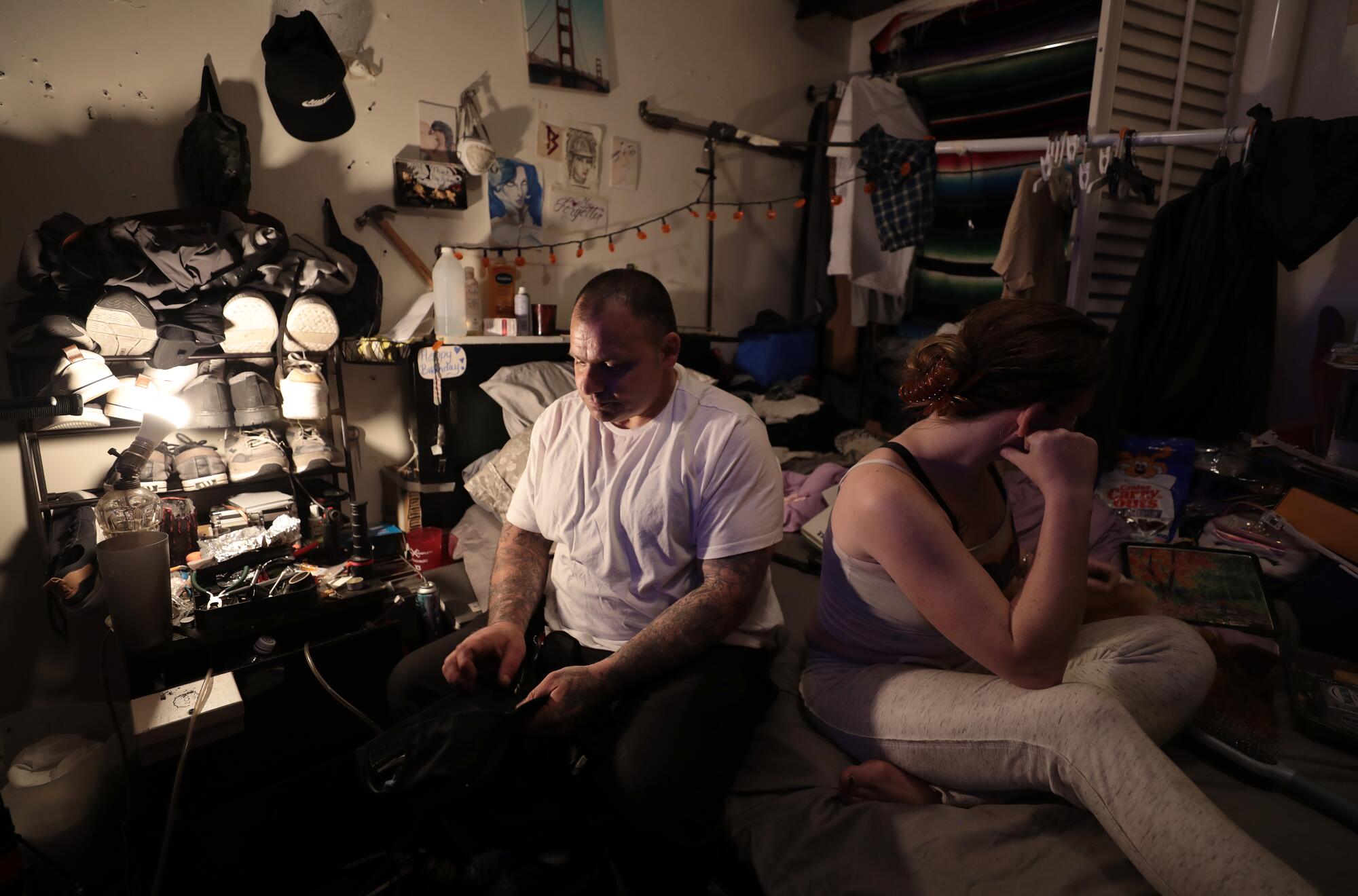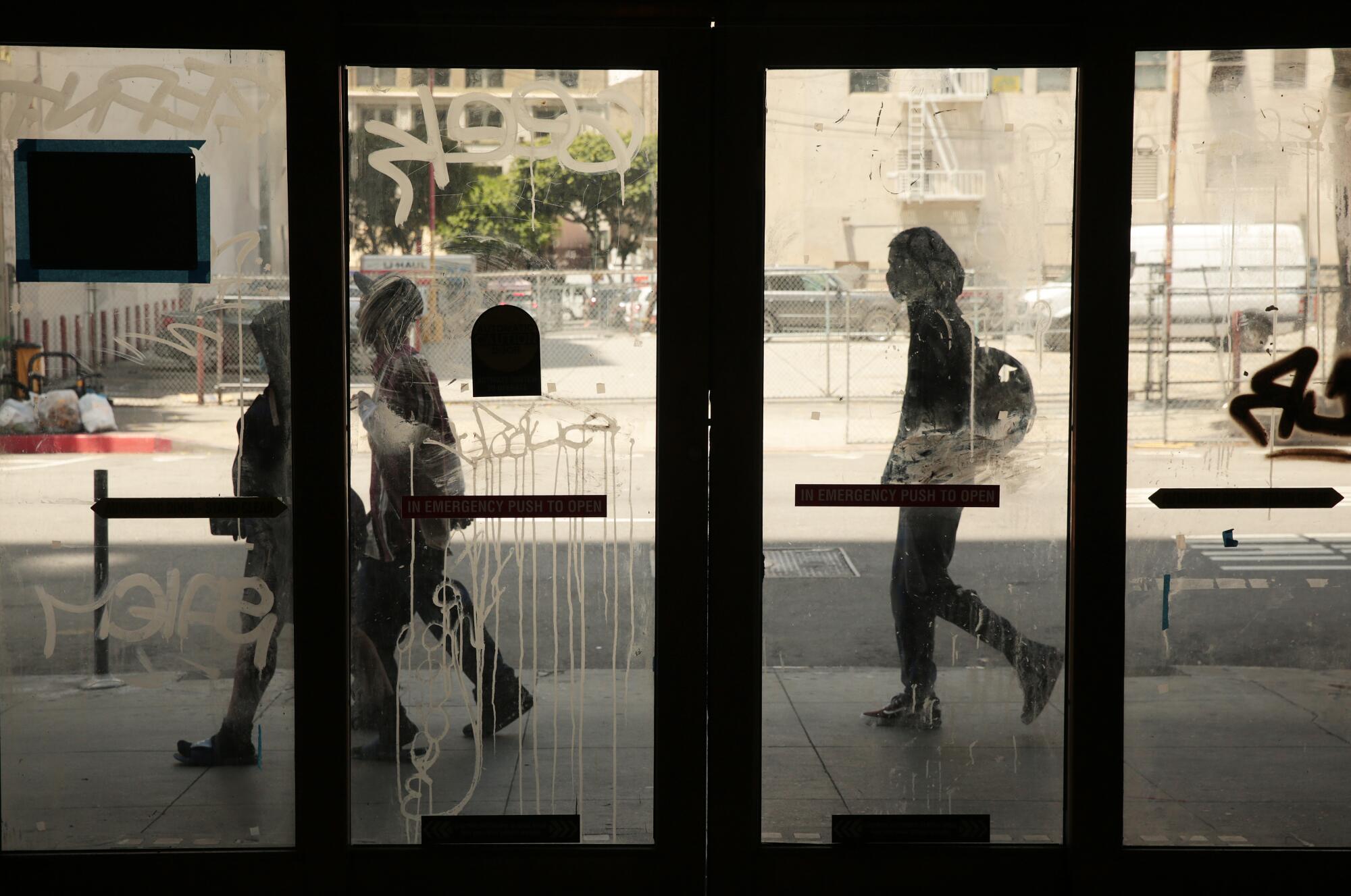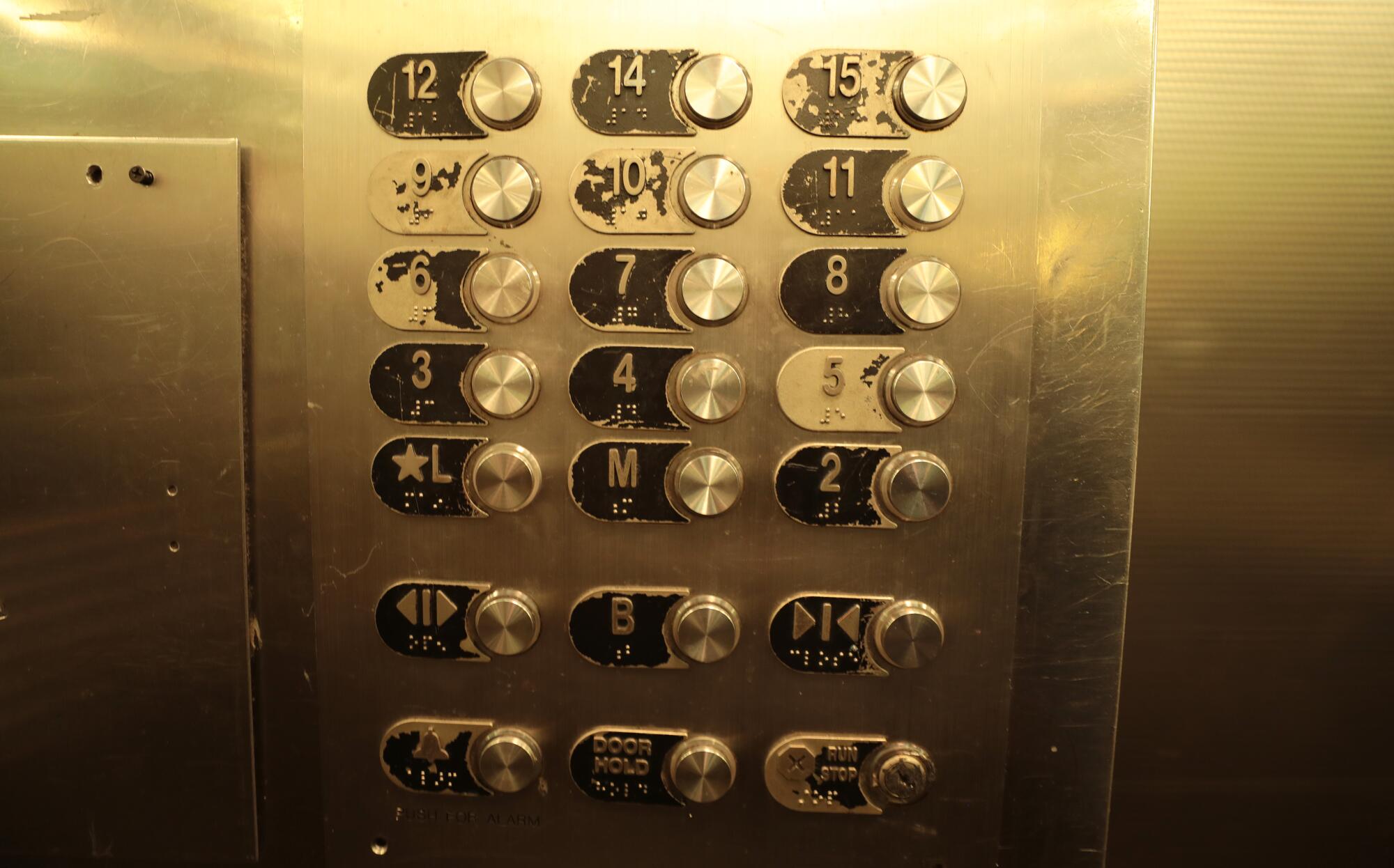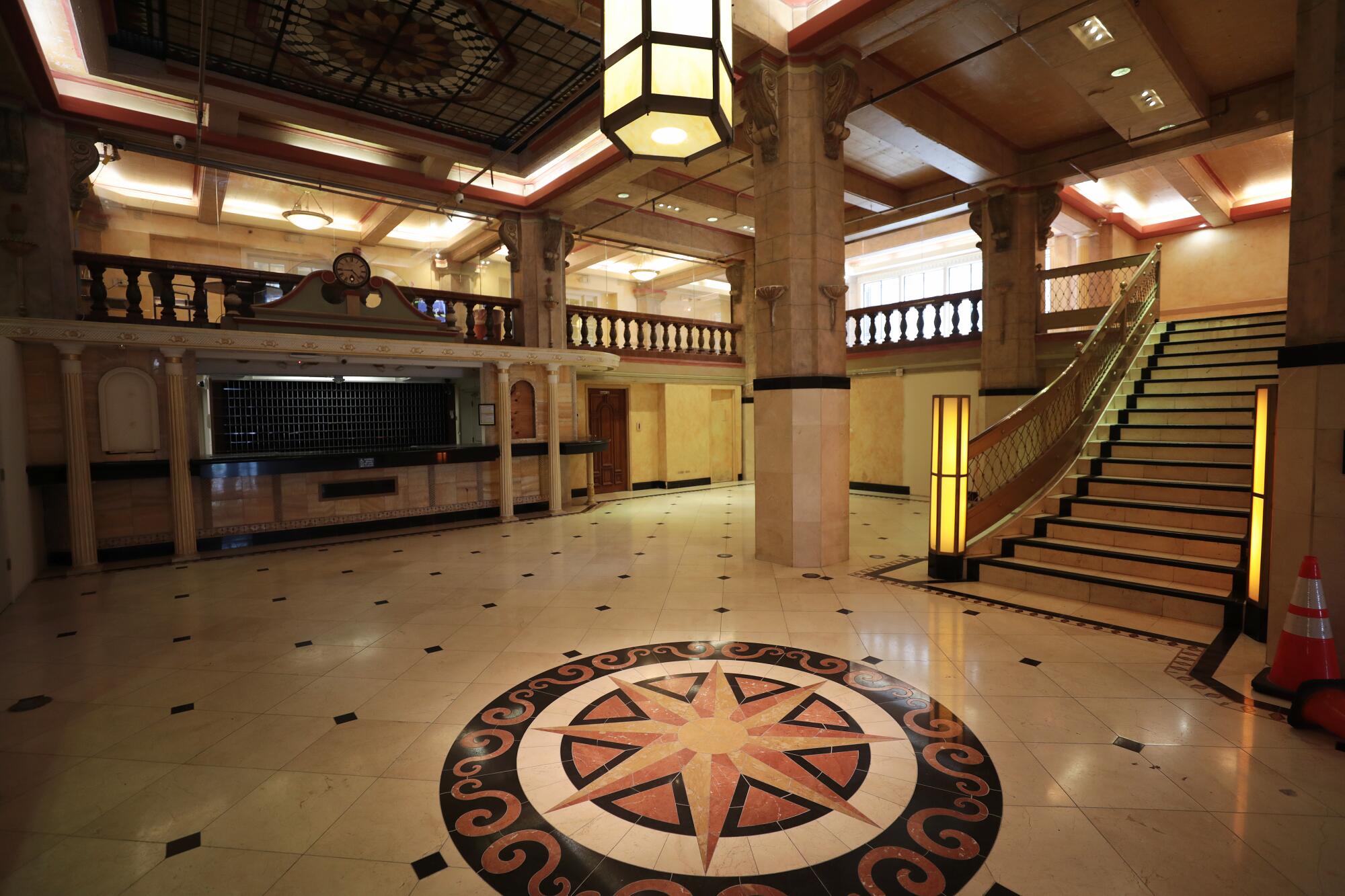Business
It takes a village to house the homeless. Residents say the Cecil Hotel is failing to provide

A homeless person is handed the keys to a room.
They can stay there at least a year — perhaps their first opportunity for stable housing in a long time. The room is lightly furnished, but a case manager will help them pick out more and show them how to fold their clothes neatly in a drawer or hang them up in the closet.
Maybe there’s an aching tooth or swollen eyelid they’ve been ignoring for a while. They’ll head downstairs to a nurse, who can examine them and help make a doctor or dental appointment.
Maybe they’re angry after a neighbor took something they left in the hall. Maybe they get into a fight in the kitchen. A security worker de-escalates the situation, and a social worker helps them take some deep breaths. A therapist talks to them about what happened. Tells them it’ll be OK.
This is the ideal for permanent supportive housing, a model of subsidized housing combined with support services that has shown to be a promising strategy in reducing chronic homelessness. When a homeless person is housed, it can take a village for them to thrive.
In Los Angeles, there are several nonprofits that have built this kind of support system for their residents. But the for-profit Cecil Hotel in downtown Los Angeles, which reopened as housing for the homeless at the end of 2021, has struggled to do the same.
Tenants have been complaining of vermin and difficult living conditions at the Cecil Hotel.
(Al Seib / For The Times)
Many who live in the Cecil say they feel abandoned. They’re worried about mold in their rooms, nonfunctioning elevators and piles of trash that build up in the hallways.
Without an on-site service provider or adequate staffing, the building has devolved into chaos, they say: Mice and roaches scurry around corners, violence leads to broken glass, and no one seems to care.
When the historic hotel a few blocks from Skid Row reopened as 600 housing units, it held immense promise as a model of how private developers could help alleviate the homelessness crisis by using the city’s existing stock of single room occupancy units.
The Cecil opened its doors to people who had been rejected by landlords wary of accepting tenants who’d lived on the streets. At 160 square feet, the rooms have a bed, nightstand, dresser and mini fridge. Some have their own bathrooms, but most residents use the communal bathrooms on each floor. The building is about half full: It has 318 residents and 75 people on deck to move in.
The building’s managers say that issues are to be expected when housing recently homeless people and that they’re working on bringing in more support services for the residents. The intention had been to have an on-site service provider before anyone moved in, but that didn’t come together, and they didn’t want the rooms to sit empty.
All of the Cecil’s residents receive rental subsidies, with some in programs funded through the Los Angeles Homeless Services Authority or the county Department of Health Services, and others with an emergency housing voucher distributed by the federal government during the COVID-19 pandemic. The federal vouchers pay for most or all of someone’s rent and can be used anywhere, as long as the unit passes inspection by the local housing authority.

Richard Silva sits with a friend in his room at the Cecil. “This is not being housed, right here,” he says.
(Al Seib / For The Times)
With the help of one of those vouchers, Richard Silva moved into the Cecil a year ago.
On a spring afternoon, he’s sitting in his room, the air heavy with the smell of cigarette smoke.
A lamp in the corner barely illuminates the space crowded with hanging bikes, shoes stacked high on racks and an assortment of furniture he’s collected. The floor is covered with piles of odds and ends, and it’s unclear which are prized possessions and which are trash.
There’s art taped to the walls. Silva proudly displays his sketchbooks and says he’s a tattoo artist, but these days he spends most of his time panhandling.
Silva says he was supposed to receive $250 for furniture and clothes but never got the money. He’s not sure where it was supposed to come from, nor does he know whom to contact about it. He thinks it was written in his lease, but he can’t find the documents.
There are spots of mold by his sink and toilet, as well as on the ceiling. He points out how a bubble under the paint on his ceiling dribbles water once in a while, but says that’s better than the steady stream that flowed during last winter’s rainstorms.
At 48, Silva has been homeless nearly half his life. Right before moving into the Cecil, he had stayed in a house through Hope of the Valley Rescue Mission, a nonprofit that runs shelters and tiny-home villages. When asked about a case manager, he shrugs.
Rowan Vansleve, Hope of the Valley’s chief financial officer, said his organization doesn’t have funding to keep in touch with clients after they’ve found a place to live.
Several of the other organizations that have placed residents at the Cecil have the same limitation, according to Deena Eberly, managing director of Eberly Co., which manages the building.

Graffiti covers the doors to the Cecil Hotel’s main lobby this spring.
(Al Seib / For The Times)
Funding to maintain supportive services at housing projects is often piecemeal and difficult to navigate.
Money can come from Measure H, L.A. County’s 2017 voter-approved tax for funding homeless services; that pool of funds is managed by the county’s Homeless Initiative and distributed through the county Department of Health Services. Money can come from the Los Angeles Homeless Services Authority, which awards federal dollars to local nonprofits. Mental health services funding can come from the county Department of Mental Health, and support for military veterans can come from still other avenues.
Residents of permanent supportive housing projects usually have their rent covered by vouchers that are attached to the building, which means they can’t take that funding with them if they choose to move elsewhere. In that setup, the organization operating the housing project applies for a batch of vouchers that will subsidize rents for all the units in the project and seeks funding for supportive services for all residents who need them.
The Cecil operates differently. It’s set up to house people who already have government funding in hand and need a place to call home. Prospective tenants apply to live there individually, just like at a regular apartment building, and their rental subsidies come from varied sources. At the start, the Cecil couldn’t predict who might end up in the building, so it had trouble planning what kinds of services they might need.
Dora Gallo, from nonprofit housing operator A Community of Friends, said that when her group applies for public funding to build a housing project, one of the first things it must do is describe its plan to offer services to the eventual residents.
“You can’t put people in apartments that have not really lived in an apartment setting for a while without providing the services,” Gallo said. “It’s not just about putting people in housing, it’s making sure people have all the tools they need to succeed in housing.”
To do so, Gallo said, her organization needs to apply for philanthropic grants and fund-raise heavily to fill in the gaps when county funding falls short.
“It’s never enough and it doesn’t pay for everything,” Gallo said.
People Assisting the Homeless, an organization that operates permanent supportive housing across California, does the same. L.A. County pays the group, which is known as PATH, to provide case management for a certain number of people every month. Any ancillary services such as on-site clinicians and life skills classes have to be funded through private grants, said Tescia Uribe, PATH’s chief program officer.
When the city and county of Los Angeles received several thousand emergency housing vouchers from the federal government in July 2021, none of them came with funding for those services.
“It was like ‘Just get people inside.’ There weren’t the resources for the retention part of it and stabilization,” Uribe said. “It’s the fallout of that that we see now.”
L.A. County provided funding for 2,100 of those voucher holders to receive case management services, which includes at least one or two drop-in visits per month.
Fifty of those are at the Cecil, but many of the building’s other residents are without case managers. Several residents said they felt like they didn’t have anyone to turn to for help because their case manager left the job and they didn’t get assigned a new one, or that they lost their case manager’s business card. Others said they don’t bother keeping in contact because they don’t think their case manager would be able to help them.

Mold spatters the wall in Rigo Veloso’s room this spring.
(Al Seib / For The Times)
For the last few months, the nonprofit JWCH Institute, funded through the county, has been offering some physical and mental health care at the Cecil. Its mobile clinic parks in front of the building twice a week.
These limited resources starkly contrast with the practice of “critical time intervention,” which emphasizes that individuals need to be “bombed” with support as soon as they get housing, Uribe said.
To address mental and physical health, deal with substance abuse and learn the social and financial skills necessary for living in an apartment, they need immediate support from all directions, according to Uribe. By tackling those issues head-on, PATH has a 90% retention rate over three years for its housing, she said.
“A lot of people don’t remember how it is to take a shower, they don’t remember how to take care of themselves, so they need that extra help,” Uribe said. “They’re also coming off living off trauma, looking over their shoulders all the time.”
Without that immediate support, things can quickly deteriorate.
Jebediah Maxwell, who moved into the Cecil in October, stopped cooking in the building’s communal kitchen this summer when he discovered the roaches. He couldn’t stomach it after seeing them come out of the oven, and recently he’s gotten multiple reports of mice on various floors.
The building’s management hired him to be a tenant liaison so residents can bring up any issues they have, but he’s tired and frustrated, saying the management is not responsive enough. He quit last week.
One of the two elevators at the Cecil has been out of service for months, and the other elevator breaks at least once a week, he said. He keeps putting in maintenance requests for the laundry room, which contains two washers and two dryers for the entire building to share. Tenants have reported mold in their rooms, and say the communal bathrooms are constantly dirty.
In recent months, he said, violence has gotten markedly worse.
“I just got assaulted by a tenant,” Maxwell said in July. “Second time I’ve been assaulted in the past two months.”
He said he’s seen many people in the building he doesn’t recognize as tenants, who have caused disturbances and made residents feel unsafe. There are also several residents who have become increasingly physically aggressive, he said, including one who broke a seventh-floor window.

Tracii Thompkins says she always goes to another floor to look for a clean bathroom because the ones on her floor are frequently unusable.
(Al Seib / For The Times)
Tracii Thompkins, who lives on that floor, said the window was covered in aluminum foil for a month before it was repaired.
“I honestly feel like they don’t care at this point,” she said of the building’s management.
Thompkins goes to sleep every night with towels stuffed under her door in an effort to keep the roaches out. But they make their way in during the day while she’s gone.
When she needs to use the bathroom, she finds herself going to other floors because the ones on her floor are always dirty or clogged, she said.
“There are literal tissues that somebody wiped their butt with and stuck it on the wall,” she said. “It’s been stuck on the wall for months.”
It’s not uncommon to see animal feces and urine in the hallways either. Some residents who own dogs don’t take them outside, Thompkins said.
The building has seven full-time workers on its janitorial and maintenance staff, with one more who comes in periodically. They’ve been fighting a losing battle.
Leslie Morales, who works in the Cecil’s management office, said that when housing people who haven’t had homes in a while, issues are to be expected.
“They’re learning,” Morales said. “They have been on the street for too long.”
The elevator problems come from tenants and visitors who cause damage by dropping items in the crack between the elevator car and doors or by slamming on the buttons, she said. There aren’t enough washers and dryers, she admitted, but she also pointed to tenants: Those who don’t budget enough money for laundry overfill the machines and cause them to break, she said.

The buttons are worn in the one functioning elevator at the Cecil Hotel.
(Al Seib / For The Times)
Many of the issues are also caused by tenants’ mental health or tenants not knowing how to express themselves properly, she said.
Morales described an incident from several months ago in which a 10th-floor resident clogged his sink, left the water running and left the room. The water flooded his room and reached all the way down to the sixth or seventh floor, she said.
Building issues can be harder to catch when housing the homeless because “the residents don’t say what’s going on,” she said.
Morales said the four staff members in management end up cleaning up messes when needed — which is frequently. Trash cans often overflow between visits from maintenance workers. And — perhaps unsurprisingly, because people with hoarding problems face a higher risk of becoming homeless — piles of furniture and boxes build up in the Cecil’s hallways.
“We are a leasing company but we’ve become … therapists, support, everything,” Morales said. “We have to end up doing janitorial.”
These maintenance issues contribute to the cost of operating the building.
Residents are grateful for a roof over their heads and a place to call their own, but living conditions are becoming intolerable.
“They’re like prison cells,” Maxwell said. “That’s what the majority of us feel like.”
The Cecil project has run into several difficulties since its inception, from negotiating rent with the city’s housing authority to getting tenants’ vouchers approved. And it seemed to encounter a lukewarm response, at first, from some of the city’s network of nonprofit partners, which the Cecil relies on to usher potential residents through its doors.
Matthew Baron, president of Baron Property Group, which owns the Cecil, said the plan always had been to have a service provider for its residents.
“The idea was originally to find a service provider before we actually started the lease-up,” Baron said.
The Cecil initially partnered with Skid Row Housing Trust to try to find one for the building and figure out how the support would be funded, he said, but that didn’t work out. The Cecil terminated its relationship with the trust in December 2022, shortly before the trust’s financial collapse.
Meanwhile, it started welcoming tenants. With more than 40,000 people experiencing homelessness in the city — and with the empty building eating away at his bottom line — Baron didn’t want to wait.
“I don’t think it’s the right thing for us to be just sitting on vacant units,” Baron said, “not letting people come in off the street just because we haven’t found the service provider yet.”
Now, he said, his team is working on fixing the problems that have cropped up.

The main lobby of the Cecil Hotel. JWCH Institute, a nonprofit healthcare provider, will soon use the space to provide medical services to residents.
(Al Seib / For The Times)
The Cecil is building a much larger laundry room, and it has two pest control contracts in place to deal with the vermin. It’s also starting a volunteer program for residents to help alert management to problems on their floor.
“We are absolutely committed to making the Cecil a safe and clean space for people to live… [and] making sure the people who live at the Cecil are provided the services that they need,” Baron said.
He’s also looking to fill up the building as quickly as possible.
The Cecil is working with PATH to fill 161 rooms and provide supportive services for those residents.
On the ground floor, JWCH will open a site for the county’s Safe Landing program, a 24/7 operation allowing any homeless individual to walk in and access food and resources, and operate 100 rooms of interim housing. The goal is to have the beginnings of those two programs in place by Sept. 1.
“We’re not done,” Baron said. “We’re kind of just still in the third or fourth inning.”
Case management services will continue to depend on individual tenants’ relationships with other organizations, but the Cecil plans for JWCH to offer on-site physical and mental health care to all tenants. JWCH leaders hope to have those clinical services up and running by November — nearly two years after the Cecil began bringing in residents.

Dexter Johnson in his room at the Cecil Hotel. Johnson said he ended up living there when no other apartment would accept his housing voucher.
(Al Seib / For The Times)

Business
Cleveland-Cliffs Signals a Possible New Bid for U.S. Steel

A possible new takeover bid for U.S. Steel emerged on Monday, teeing up more turmoil over the once-dominant company’s future after President Biden’s decision to block its acquisition by a Japanese company.
Lourenco Goncalves, the chief executive of an American competitor, Cleveland-Cliffs, said his company had “an All-American solution to save the United States Steel Corporation,” stressing that acquiring U.S. Steel was a matter of “when,” not “if.” But he offered no details of the bidding plans.
The renewed expression of interest from Cleveland-Cliffs comes less than two weeks after Mr. Biden blocked a $14 billion takeover of U.S. Steel by Nippon Steel, arguing that the sale posed a threat to national security. Cleveland-Cliffs tried to buy U.S. Steel in 2023, an offer that was rejected in favor of Nippon’s higher bid.
CNBC reported on Monday morning that Cleveland-Cliffs would seek to take over U.S. Steel and sell off its subsidiary, Big River Steel, to Nucor, another American producer. But Mr. Goncalves, at a news conference later in the day, would not confirm any partnership with Nucor on a bid.
U.S. Steel and Nucor did not immediately respond to requests for comment.
Investors seemed pleased by the potential bid, sending shares of U.S. Steel up as much as 10 percent on Monday when CNBC reported the potential offer. Shares of U.S. Steel finished about 6 percent higher on Monday but are down 23 percent over the past year, including Monday’s spike.
But the fate of Nippon’s proposed takeover remains in limbo. U.S. Steel and Nippon sued the United States government last week in the hopes of reviving their merger, accusing Mr. Biden and other senior administration officials of corrupting the review process for political gain and blocking the deal under false pretenses.
The companies filed a separate lawsuit against Cleveland-Cliffs, Mr. Goncalves and David McCall, international president of the United Steelworkers union. They argue that Cleveland-Cliffs and the head of the union illegally colluded to undermine the Nippon deal, assertions that both defendants called “baseless.”
On Saturday, the companies said the Biden administration had delayed enforcement of its executive order blocking Nippon’s takeover until June, to give the courts time to review the lawsuit.
“The problem is, we can’t make anything happen until the current management and the current board of U.S. Steel make the decision to abandon the merger agreement with Nippon Steel,” Mr. Goncalves said at a news conference in Butler, Pa., on Monday.
Given this rancor, it is unclear how receptive U.S. Steel would be to a new bid by Cleveland-Cliffs. If U.S. Steel does not engage, one option would be for Cleveland-Cliffs to take an offer to shareholders.
U.S. Steel was once the world’s largest steel producer, but the company has fallen in global rankings in recent years. Concerns about its long-term future are rooted in a failure to quickly adopt alternatives to traditional mills that are more energy-efficient and cost-effective. Nippon, U.S. Steel has argued, is the only buyer that can make substantial investments in multiple steel mills and protect jobs.
The United Steelworkers, which represents 11,000 U.S. Steel employees, has voiced strong opposition to the proposed merger with Nippon. The powerful union has said the Japanese company engaged in illegal trade practices and dealt with the union in bad faith. Previously, the union expressed its preference for a merger with Cleveland-Cliffs, which is unionized.
A new bid by Cleveland-Cliffs, if it materializes, risks antitrust scrutiny from federal antitrust regulators, though regulators in the Trump administration are widely expected to take a less aggressive approach to merger enforcement than their Biden administration predecessors.
Business
Supreme Court denies oil industry plea to block climate lawsuits filed by California, other blue states

WASHINGTON — The Supreme Court dealt a major setback to the oil industry Monday, refusing to block lawsuits from California and other blue states that seek billions of dollars in damages for the effects of climate change.
Without a comment or dissent, the justices turned down closely watched appeals from Sunoco, Shell and other energy producers.
In Sunoco vs. Honolulu, the oil industry urged the justices to intervene in these state cases and rule that because climate change is a global phenomenon, it is a matter for federal law only, not one suited to state-by-state claims.
“The stakes could not be higher,” they told the court.
But none of the justices said they wanted to hear their claim, at least not now.
The decision clears the way for more than two dozen suits filed by states and municipalities to move forward and try to prove their claim that the major oil producers knew of the potential damage of burning fossil fuels but chose to conceal it.
“Big Oil companies keep fighting a losing battle to avoid standing trial for their climate lies,” said Richard Wiles, president of the Center for Climate Integrity. “With this latest denial, the fossil fuel industry’s worst nightmare — having to face the overwhelming evidence of their decades of calculated climate deception — is closer than ever to becoming a reality.”
Two years ago, California Gov. Gavin Newsom and Atty. Gen. Rob Bonta filed a lawsuit in San Francisco County Superior Court against five of the largest oil and gas companies — Exxon Mobil, Shell, Chevron, ConocoPhillips and BP — and the American Petroleum Institute for what they described as a “decades-long campaign of deception” that created climate-related harms in California.
“For more than 50 years, Big Oil has been lying to us — covering up the fact that they’ve long known how dangerous the fossil fuels they produce are for our planet,” Newsom said in announcing the suit.
In recent days, California officials have blamed climate change for the devastating weather conditions that contributed to the deadly wildfires that destroyed thousands of homes and other structures, leading to what many experts expect to become the costliest natural disaster in U.S. history.
California’s suit followed the pattern set by similar claims from the cities of Baltimore, New York, Chicago and San Francisco as well as blue states including Massachusetts, Connecticut, Rhode Island, New Jersey and Minnesota.
These suits argue that the oil producers used deceptive marketing to hide the danger of burning fossil fuels. Under state law, companies can be held liable for failing to warn consumers of a known danger.
In June 2024, the court asked the Justice Department to weigh in on the issue. In December, lawyers for the Biden administration urged the court to stand aside for now because the suits are at an early stage.
Justice Samuel A. Alito Jr. said he took no part in the decision to deny the appeals, presumably because he owns stock in companies affected by the dispute.
The climate change lawsuits were patterned after the successful mass lawsuits filed by states and others against the tobacco industry over cigarettes and the pharmaceutical industry over opioids.
Cigarettes and opioids were sold legally, but the suits alleged that industry officials conspired to deceive the public and hide the true dangers of their highly profitable products.
Under state law, plaintiffs can seek damages for broad and open-ended claims such as a failure to warn of a danger, false advertising or creating a public nuisance. All three claims are cited in California’s lawsuit. Federal law, by contrast, is usually limited to damage claims that are authorized by Congress.
Had the Supreme Court agreed to hear the oil industry’s appeal in the Hawaii case, it “would have frozen the cases for a year or more and could have resulted in a death blow for all of them,” said Patrick Parenteau, an environmental law expert at the Vermont Law School.
Los Angeles lawyer Theodore J. Boutrous Jr., who represents Chevron, said the company “will continue to defend against meritless state law climate litigation, which clashes with basic constitutional principles, undermines sound energy policy.”
Meanwhile, Alabama and 20 red states urged the court to throw out these blue-state lawsuits. They said liberal states and their judges should not have the power to set the nation’s policy on the energy industry. The court has not ruled on that claim yet.
The case dismissed Monday began five years ago when the city and county of Honolulu sued Sunoco and 14 other major oil and gas producers, alleging a failure to warn and creating a nuisance.
The Hawaii Supreme Court last year rejected the industry’s motion and refused to dismiss the suit.
“Simply put, the plaintiffs say the issue is whether defendants misled the public about fossil fuels’ dangers and environmental impact. We agree …. This suit does not seek to regulate emissions and does not seek damages for interstate emissions,” the state court said in a unanimous opinion. “Rather, plaintiffs’ complaint clearly seeks to challenge the promotion and sale of fossil-fuel products without warning and abetted by a sophisticated disinformation campaign.”
Business
How the NFL Moved the Vikings-Rams Playoff Game Away From the L.A. Fires

Matthew Giachelli got the call he anticipated on Thursday morning: The N.F.L. was moving the Rams’ playoff game to Arizona because of the wildfires raging in Los Angeles, and the league needed 200 gallons of paint pronto.
The game on Monday between the Rams and the Minnesota Vikings would now be held at State Farm Stadium outside Phoenix, and it had to look and feel as if it were being played in the Rams’ usual home, SoFi Stadium. That included painting the field with the team’s and league’s logos and colors. The hometown Cardinals, though, did not have some of the needed hues on hand, including the Rams’ blue and yellow.
Giachelli’s company, World Class Athletic Surfaces in tiny Leland, Miss., provides paint to most N.F.L. and top college teams. Within hours, he and his co-workers had loaded five-gallon buckets of nine custom paint colors, as well as stencils for the N.F.L. playoff logos, onto a truck that left Thursday afternoon on a 1,500-mile journey to Arizona.
“I definitely regret what’s going on in California, but I’m glad we could meet their needs,” said Giachelli, the vice president of production and distribution.
Getting the right paint was just one of hundreds of details that the league, the Rams, the Vikings, the host Arizona Cardinals and ASM Global, which operates State Farm Stadium, have juggled since the N.F.L. decided to move the wild-card round game.
The N.F.L. has canceled preseason games and postponed and moved regular-season games over the years because of hurricanes, snowstorms and other calamities. But it had not moved a winner-take-all playoff showdown since 1936, when the site of its championship game was changed from Boston to New York to drum up ticket sales.
A battalion of people — from the front-office workers to the training staffs to the thousands of game-day workers — have been mobilized on short notice. Each game, particularly in the playoffs, generates tens of millions of dollars for television networks, advertisers and stadium operators, and with the season coming down to its last few weeks, there was little margin for error.
“If it can be played, they play it, and in this case, it can be played in Glendale,” said Joe Buck, who will call the game for ESPN on Monday. “We’re in the playoffs now, and you’ve got all this pressure to get this first round finished before Kansas City and Detroit,” which had first-round byes, “get back in.”
A big reason the N.F.L. is the world’s most valuable league is scarcity. There are just 272 regular-season games and 13 playoff games, so each one is of critical importance to the 32 teams. (By contrast, there are about 400 Major League Baseball games every month during the season.) They are also critical to the owners of those teams and the league, as well as broadcast networks, sponsors and other companies that spend billions of dollars a year to attach their businesses and brands to the N.F.L.
It has not escaped notice that one of those businesses, State Farm, will have its name attached to Monday night’s broadcast less than a year after it announced that it would not renew 30,000 homeowner policies and 42,000 policies for commercial apartments in California. (The N.F.L. has donated $5 million to Los Angeles relief efforts.)
With so much riding on each contest, the N.F.L. does everything it can to play every game every year. When the league creates its season schedule each spring, it prepares contingency plans including an alternate site for each game. In 2022, when a massive snowstorm hit western New York, the Buffalo Bills played a home game at Ford Field in Detroit.
During the pandemic, outbreaks in locker rooms forced the league to postpone several games, though none were canceled. When pandemic conditions in Santa Clara County, Calif., deteriorated, the San Francisco 49ers moved to Arizona for a month, playing three home games in State Farm Stadium. Arizona was also a backstop in 2003 when the Chargers moved their home game against the Miami Dolphins because of fires in San Diego.
This time, the fires spread so quickly, the league decided to move the game five days before kickoff. Kevin Demoff, the president of the Rams, said the team had been in constant contact with officials in Los Angeles, who initially thought the game could be held at SoFi Stadium in Inglewood, which was unaffected by the fires.
But that changed midweek, when fires broke out close to the team’s training facility in Woodland Hills, forcing some players and staff to evacuate their homes and for one practice to be cut short. Demoff said he did not want the players and staff to be distracted, nor did he want city and county resources to be diverted for the game when they could be used to help others in need.
Moving the game is “just a recognition that there’s some things bigger than football and we owe this to our community to make sure that this game can be played safely and not be a distraction,” Demoff said Friday.
ESPN was on hold as well. Four of its production trucks were en route to Los Angeles from Pittsburgh when the league told the network on Wednesday night that the game could be moved to Glendale. The crews spent the night in Kingman, Ariz. On Thursday, the plan was to set up in both stadiums in case the league waited until Saturday to decide where to play. So the trucks continued on to Los Angeles while another set of trucks left for Glendale. When the N.F.L. said Thursday that the game had been moved, the first set of trucks, which had reached Ontario, Calif., turned around and arrived in Glendale with time to spare.
The Cardinals also helped out the Rams in ways beyond just lending their stadium. The team’s owner, Michael Bidwill, sent two team planes to Los Angeles to help the Rams get their entourage and equipment to Arizona.
-

 Politics1 week ago
Politics1 week agoWho Are the Recipients of the Presidential Medal of Freedom?
-

 Health1 week ago
Health1 week agoOzempic ‘microdosing’ is the new weight-loss trend: Should you try it?
-
/cdn.vox-cdn.com/uploads/chorus_asset/file/25822586/STK169_ZUCKERBERG_MAGA_STKS491_CVIRGINIA_A.jpg)
/cdn.vox-cdn.com/uploads/chorus_asset/file/25822586/STK169_ZUCKERBERG_MAGA_STKS491_CVIRGINIA_A.jpg) Technology5 days ago
Technology5 days agoMeta is highlighting a splintering global approach to online speech
-

 Science3 days ago
Science3 days agoMetro will offer free rides in L.A. through Sunday due to fires
-

 News1 week ago
News1 week agoSeeking to heal the country, Jimmy Carter pardoned men who evaded the Vietnam War draft
-
/cdn.vox-cdn.com/uploads/chorus_asset/file/25821992/videoframe_720397.png)
/cdn.vox-cdn.com/uploads/chorus_asset/file/25821992/videoframe_720397.png) Technology6 days ago
Technology6 days agoLas Vegas police release ChatGPT logs from the suspect in the Cybertruck explosion
-

 Movie Reviews1 week ago
Movie Reviews1 week ago‘How to Make Millions Before Grandma Dies’ Review: Thai Oscar Entry Is a Disarmingly Sentimental Tear-Jerker
-

 News1 week ago
News1 week agoTrump Has Reeled in More Than $200 Million Since Election Day














